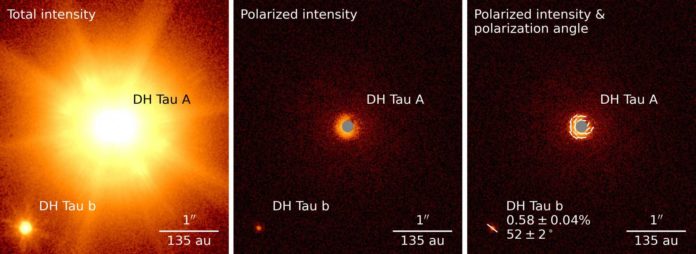An international team led by Dutch astronomers has, for the first time, directly captured polarized light from an exoplanet called DH Tau b. After years of searching and defying a telescope’s boundaries, astronomers were able to deduct from the light that a disk of dust and gas is orbiting around the exoplanet.
Exoplanet DH Tau b is a very young planet of only 2 million years old. It is located at 437 light-years from Earth in the constellation Taurus and at least eleven times more massive than Jupiter.
The interesting fact about the planet is that it is still glowing after its formation; hence, it emits heat in infrared radiation.
Astronomers noted, “the infrared radiation of the planet is polarized, meaning the light waves vibrate in a preferential direction. This is because the planet’s infrared radiation is scattered by a disk of dust and gas that orbits the planet. In such a disk, moons may form.”
The planet has a disk around itself with a different orientation. This disk’s tilt indicates that the planet has likely formed at a large distance from the star. This is contrary to the theory that planets are formed close to their star and then migrate outward.
First author and research leader Rob van Holstein (Leiden University, the Netherlands) has been working with the SPHERE instrument since his university study in 2014: “Because we fully understood the instrument, we were able to make it perform better than it was designed for. In the end, we were able to capture the light from twenty exoplanets, one of which had polarized light.”
Co-author Frans Snik (Leiden University) has been trying to capture polarized light from planets since 2012: “It’s already very special that we can see a planet separated from the star around which it orbits. And now we can also deduce that material is orbiting this planet as well and that this material does so at a completely different angle than the disk that orbits the star. This gives us unique insights into how such a planet and possible moons are formed.”
In the future, scientists want to use an Extremely Large Telescope (which is under construction) to carry out similar research.
Journal Reference:
- R. G. van Holstein et al. A survey of the linear polarization of directly imaged exoplanets and brown dwarf companions with SPHERE-IRDIS. First polarimetric detections revealing disks around DH Tauri B and GSC 6214-210 B, Astronomy & Astrophysics (2021). DOI: 10.1051/0004-6361/202039290
